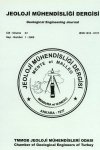
ABSTRACT: The lithologies of Emirgazi formation (Precambrian), Zabuk formation (Lower Cambrian), Değirmentaş formation (Middle Cambrian) and Armutludere formation (Ordovisian) which belong to Geyikdağ unit located in Tauride tectonic unit crop out at and around of Karaçat iron deposit. According to actual position, the contact between deposit and host rocks of Zabuk, Değirmentaş and Armutludere formations is tectonically controlled. Post-mineralisation faults caused the deposit to expose. Karstification and weathering developed at contact zones, caused alterations from siderites and iron oxides to limonites and goethites. As a result of above mentioned processes partly enriched iron levels formed raw material for explotation. The deposit has a reserve of 25 millions tons of proven and probable category. Ore mineralizations consist of hematites and goethites which are mostly alteration products of siderites. In addition to siderites, pyrite and limonites-goethites accompany to them and pyrite, pyrolusite and psilomelane, limonite (goethite), rutile, anatase and carbonate minerals are observed together with hematites. In addition, manganese minerals and rutile-anatase occur in either as inclusions or fillings in limonites and euhedral pyrites take place in the cavities of limonites. CaO, 0,02- 8,92 % SiO2, 0,68-1,10 % MnO; hematites (n=2); 77,17-84,33 % Fe2O3 (total iron), 6,80-8,61 % SiO2, 0,36-2,19 % CaO, 1,37-1,49 % MnO and limonites goethites (n=2);77,73-79,53 % Fe2O3 (total iron), 6,20-7,85 % CaO, 0,52-3,59 % SiO2, 1,01-1,15 % MnO. At the northwestern part of Karaçat iron ore deposits, fuchsite and viridian (Cr2O3.2H2O) minerals have been detected in the basic volcanic samples intercalated with siderites of Precambrian aged Emirgazi formation and these basic volcanic rocks carry the same lithochemical signatures like the ones determined on the country rocks of Attepe iron ore deposit. The presence of diabase dykes intersecting metasandstone-claystone rocks of Precambrian aged Emirgazi formation which is located in far southern part of Bekirhacılı village have been detected in the context of this study. Geochemical analyses of these dykes indicated Cr2O3 values of up to 3200 ppm. Due to ore microscopic studies, chromite minerals are also determined. The high Cr2O3 value attracts attention. Apart from this data, although no outcrop has been found, some basic volcanic rock fragments are observed in the close vicinity of southeastern part of this location. Metasedimentary rocks interlayered with volcanics of Precambrian aged Emirgazi formation located at the southern part of Bekirhacılı village have been found within the framework of this study. Basic volcanic rock fragments (spilites) observed in polygenic conglomerate or polygenic coarse grained sandstone of these metasedimentary sequence supported by high Cr values (418 ppm). Apart from acidic and intermediate volcanic rocks which are previously found in Precambrian aged Emirgazi formation, basic volcanic rocks (bimodal volcanism) have recently been found out. This peculiar result is curicial in terms of genesis and regional geology. When interpreted together with previous studies, it can be concluded that iron deposits at Yahyalı (Kayseri) and Mansurlu (Feke-Adana) districts are closely associated with volcanic syn-sedimentary or exhalative sedimentary iron ore deposits. The late stage processes and phases are characterized by (1) chemical migration of Fe from Precambrian aged deposits and occurrences to the younger units, (2) metamorphism and late stage folding and fault tectonics, (3) migration of Fe-bearing fluids in to permeable zones, (4) metasomatism, and (5) karstification. Therefore, Karaçat iron ore deposit is inferred to represent the formation of migration from Precambrian aged probably primary iron deposits and deformed ones. Thus, Precambrian lithologies seems to be extremely important to form a basis for further exploration studies.
ABSTRACT: In the lake which was formed as a result of the blocking of Çakıt River by landslide in the investigationarea (Belemedik Pozantı/Adana), 20 m thick delta-lake facies complex deposits were formed. 4 mainfacies association were identified in Belemedik Delta. First of them is composed of conglomerates havingvaried grain size and sandstones. This facies association shows plannar cross bedding and graded beddingand represents proximal part of the braided river system. The second-facies association consists ofconglomerates, sandstones, siltstones and claystone. Channel geometry is typical in this association.Alternating sand-silt laminations and small scaled cross beddings and ripple marks are abundant nearupper levels. Third facies association represented by siltstone, claystone and sandstone alternations.Ripple laminations and cross beddings are abundant. That facies association shows delta bottom setdeposits. Fourth-facies association is characterized by large lateral extension of plannar or ripplelaminated sediments. Sandstones in this association have fine to very fine grain size. This faciesassociation shows that it occurred to by the deposition of materials like silt and fine sand by turbiditycurrents in the front part of the delta environment (lake environments).
ABSTRACT: Geological process is a part of environment around us containing geological materials and places.Lots of subjects about the quality of life including health and security are concerned with geologicalenvironment. Therefore, therapeutic geology was used for the last thousands of years and has beenpresently made use of it. Primitive men learned the therapeutic effect of soil-eating and Rolling in mudboth instinctly and by observing the sick animals. Geological materials have always had importance sinceSumerian and Egyptian physicians made drugs and clay tablets (Terra Sigillata) in the island of Lemnos.Ithas been considered that making use of antique thermal water is the same as the Spa organization of today. Medical geology is an interdisciplinary scientific field which studies the positive or negativeeffects of the geological environment on the humans, animals and plants. Medical geology examines thedetermination of therapeutic character of geological environment and potantial usage of it as much as therisks. In this study, the scopes of therapeutic geology have been emphasized on the basis of the principlesof medical geology.

 TMMOB
TMMOB